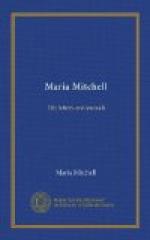The relation between herself and her pupils was quite remarkable—it was very cordial and intimate; she spoke of them always as her “girls,” but at the same time she required their very best work, and was intolerant of shirking, or of an ambition to do what nature never intended the girl in question to do.
One of her pupils writes thus: “If it were only possible to tell you of what Professor Mitchell did for one of her girls! ‘Her girls!’ It meant so much to come into daily contact with such a woman! There is no need of speaking of her ability; the world knows what that was. But as her class-room was unique, having something of home in its belongings, so its atmosphere differed from that of all others. Anxiety and nervous strain were left outside of the door. Perhaps one clue to her influence may be found in her remark to the senior class in astronomy when ’76 entered upon its last year: ‘We are women studying together.’
“Occasionally it happened that work requiring two hours or more to prepare called for little time in the class. Then would come one of those treats which she bestowed so freely upon her girls, and which seemed to put them in touch with the great outside world. Letters from astronomers in Europe or America, or from members of their families, giving delightful glimpses of home life; stories of her travels and of visits to famous people; accounts of scientific conventions and of large gatherings of women,—not so common then as now,—gave her listeners a wider outlook and new interests.
“Professor Mitchell was chairman of a standing committee of the American Association for the Advancement of Women,—that on women’s work in science,—and some of her students did their first work for women’s organizations in gathering statistics and filling out blanks which she distributed among them.
“The benefits derived from my college course were manifold, but time and money would have been well spent had there been no return but that of two years’ intercourse with Maria Mitchell.”
Another pupil, and later her successor at Vassar College, Miss Mary W. Whitney, has said of her method of teaching: “As a teacher, Miss Mitchell’s gift was that of stimulus, not that of drill. She could not drill; she would not drive. But no honest student could escape the pressure of her strong will and earnest intent. The marking system she held in contempt, and wished to have nothing to do with it. ’You cannot mark a human mind,’ she said, ‘because there is no intellectual unit;’ and upon taking up her duties as professor she stipulated that she should not be held responsible for a strict application of the system.”
“July, 1887. My students used to say that my way of teaching was like that of the man who said to his son, ’There are the letters of the English alphabet—go into that corner and learn them.’




